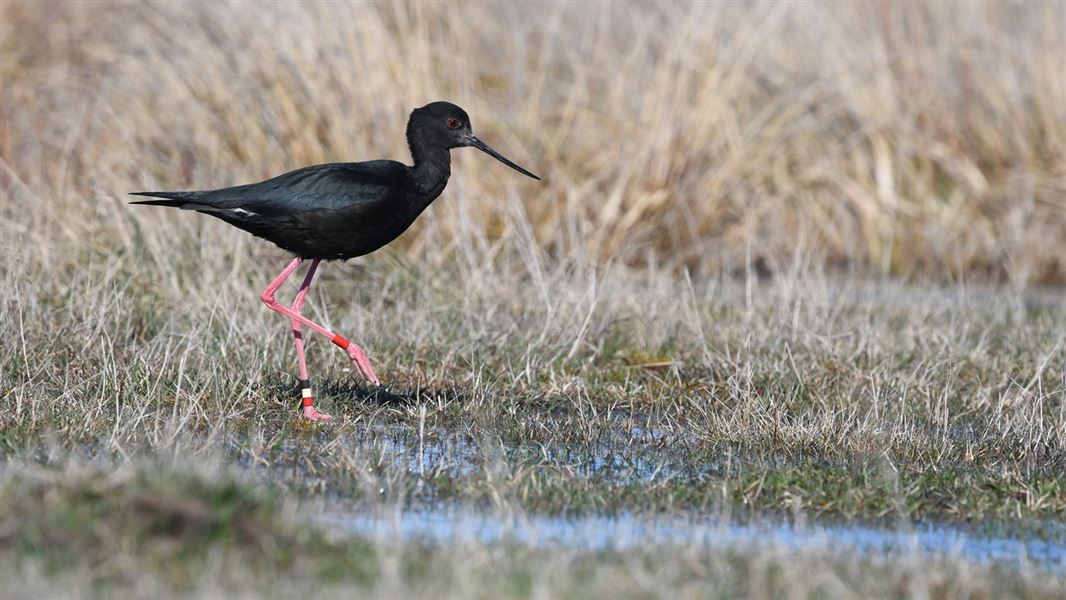Population: About 169 wild adult birds as of August 2023
New Zealand status: Endemic
Conservation status: Threatened–Nationally Critical
Found in: Braided rivers and wetlands of the Mackenzie Basin, South Island
Threats: Predation, habitat loss, disturbance
Sound recording:
Adult black stilt/kakī song (MP3, 2,380K)
02:36 – Territorial and alarm calls of two adults protecting their young
Our bird songs can be reused, even commercially, according to our copyright terms.
Species information: Black stilt on NZ Birds Online
Image gallery
Kakī conservation
Emergency hotline
Call 0800 DOC HOT (0800 362 468) immediately if you see anyone catching, harming or killing native wildlife.
Kakī (Himantopus novaezelandiae) are found in braided riverbeds, side streams, swamps and tarns and sometimes on lake margins and irrigated paddocks if there is good feed available. Most riverbed birds migrate to coastal areas in winter, but kakī usually remain in the Mackenzie Basin despite parts of their habitat freezing over.
Kakī can form lifelong pairs. Due to their low numbers, if they cannot find a kakī mate, they may sometimes breed with the pied stilt/poaka. Historically hybridisation was an issue, but with intensive management, this has been greatly reduced.
The main threats to kakī include:
- Predators – especially introduced mammalian predators like feral cats and ferrets. Kakī also have aerial predators such as harriers and black-backed gulls.
- Habitat loss and modification – such as hydroelectric and agricultural development and weed invasion.
- Human disturbance – recreational users of riverbeds and wetlands can crush eggs or chicks and scare adult kakī away from their nests.
The challenge now is to learn how and when to manage these threats. Targeted research will help to identify the most effective and efficient management techniques to use. With the support of landowners, recreationists and the general public, we hope that kakī will thrive in their natural habitat once more.
Kakī recovery programme
Did you know?
Within hours, newly hatched chicks can hunt for food and swim if necessary.
Kakī have been intensively managed since 1981 when their population declined to a low of just 23 birds. DOC's captive breeding centre, near the town of Twizel in the Mackenzie Basin, plays an important role in the Kakī Recovery Programme.
In partnership with the Isaac Conservation and Wildlife Trust in Christchurch, a number of breeding pairs are held in captivity. Eggs are collected from both captive pairs and wild breeding pairs. Kakī eggs are artificially incubated and the young chicks are raised in captivity. At 3–9 months they are released into the wild. Rearing them in captivity significantly increases their chances of survival by preventing predation when they are most vulnerable. This also reduces the chance of incubating adults being taken by predators while on the nest. By collecting eggs, the birds are encouraged to lay multiple clutches per year, which increases the number of eggs available for artificial incubation.
Conservation efforts to date have succeeded in averting extinction and increasing kakī numbers. Kakī numbers in the wild reached a high of 170 adults in both 2019/20 and 2020/21, and the most recent 2022 population update estimates at least 143 adult kakī in the wild. Once kakī are released from captivity, an average of 30% will survive to breeding age. However, this can be as high as 57% if optimal environmental conditions are present and in areas where large-scale predator control is in operation. There has also been an increase from four productive kakī pairs in 1999 to 41 pairs in 2024 which shows real progress.
With the support of landowners, recreationalists and the general public, we hope that kakī will thrive in their natural habitat once more.
You can help
- Do not drive in riverbeds from August to December.
- Birds swooping, circling or calling loudly probably have nests nearby. Move away so they can return to them, or their eggs and chicks could die.
- Watch The Black Silt documentary on NZ on Screen
- Keep updated on the Kakī Recovery Programme on their Facebook page
- Visit the Isaac Conservation and Wildlife Trust website
- Learn about Project River Recovery
- Visit the Te Manahuna Aoraki website
